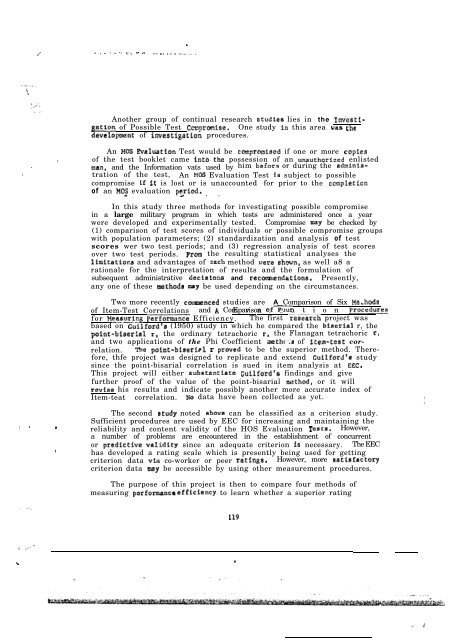Technical Report - International Military Testing Association
Technical Report - International Military Testing Association
Technical Report - International Military Testing Association
You also want an ePaper? Increase the reach of your titles
YUMPU automatically turns print PDFs into web optimized ePapers that Google loves.
.1 , .I . . ., .;., ., _-<br />
.<br />
-.< “. ,:. ,L ,._.,._. _<br />
Another group of continual research studies lies in the Inv’eetf-<br />
Bation of Possible Test Ccmpromiee. One study i.n this area vns the<br />
davelopwnt of investigation procedures.<br />
An MOS !Zvslustion Test would be comprolaiaed if one or more copltes<br />
, of the test booklet came into.tho possession of an unauthorized enlisted<br />
_ nun, and the Information vats used by him before or during the admints-<br />
/ tration of the test, An HOS Evaluation Test is subject to possible<br />
compromise if it is lost or is unaccounted for prior to the ccmpletion<br />
of an “02 evaluation p%riod. . .<br />
: . .<br />
. .<br />
., _,‘.<br />
.<br />
.<br />
In this study three methods for investigating possible compromise<br />
in a large military program in which tests are administered once a year<br />
were developed and experimentally tested. Compromise may be checked by<br />
(1) comparison of test scores of individuals or possible compromise groups<br />
with population parameters; (2) standardization and analysis of test<br />
scores wer two test periods; and (3) regression analysis of test scores<br />
over two test periods. prom the resulting statistical analyses the<br />
limitatfors and advantages of each method vere shovn, as well a8 a<br />
rationale for the interpretation of results and the formulation of<br />
subsequent administrative decisions and recolmlendations, Presently,<br />
any one of these metho,ds may be used depending on the circumstances.<br />
Two more recently carsrenced studies are A Comparison of Six Me,hoda<br />
of Item-Test Correlations and k Comparison E v a of%ur l u a t i o n Proceduref!<br />
for Pieasuring ParforuGG Efficiency. The first fesearch project was<br />
based on Cuilford’s (1950) study in which he compared the biaerfal r, the<br />
point-bieer?al r, the ordinary tetrachoric r, the Flanagan tetrachoric r,<br />
and two applications of the Phi Coefficient methc-;s of itein-tese correlation.<br />
~%a point-biseripl r proved to be the superior method. Therefore,<br />
thfe project was designed to replicate and extend Gutlford’e study<br />
since the point-bisarial correlation is sued in item analysis at EbC.<br />
This project will either substuntiate Guilford’s findings and give<br />
further proof of the value of the point-bisarial method, or it will<br />
reviee his results and indicate possibly another more accurate index of<br />
Item-teat correlation. ho data have been collected as yet.<br />
The second study noted above can be classified as a criterion study.<br />
Sufficient procedures are used by EEC for increasing and maintaining the<br />
reliability and content validity of the HOS Evaluation Tests. However,<br />
a number of problems are encountered in the establishment of concurrent<br />
or predfctive val:ldfty since an adequate criterion is necessary. The EEC<br />
has developed a rating scale which is presently being used for getting<br />
criterion data via co-worker or peer ratings. However, more satfsfactory<br />
criterion data msy be accessible by using other measurement procedures.<br />
The purpose of this project is then to compare four methods of<br />
measuring perfor=mancaefficiency to learn whether a superior rating<br />
119<br />
,









